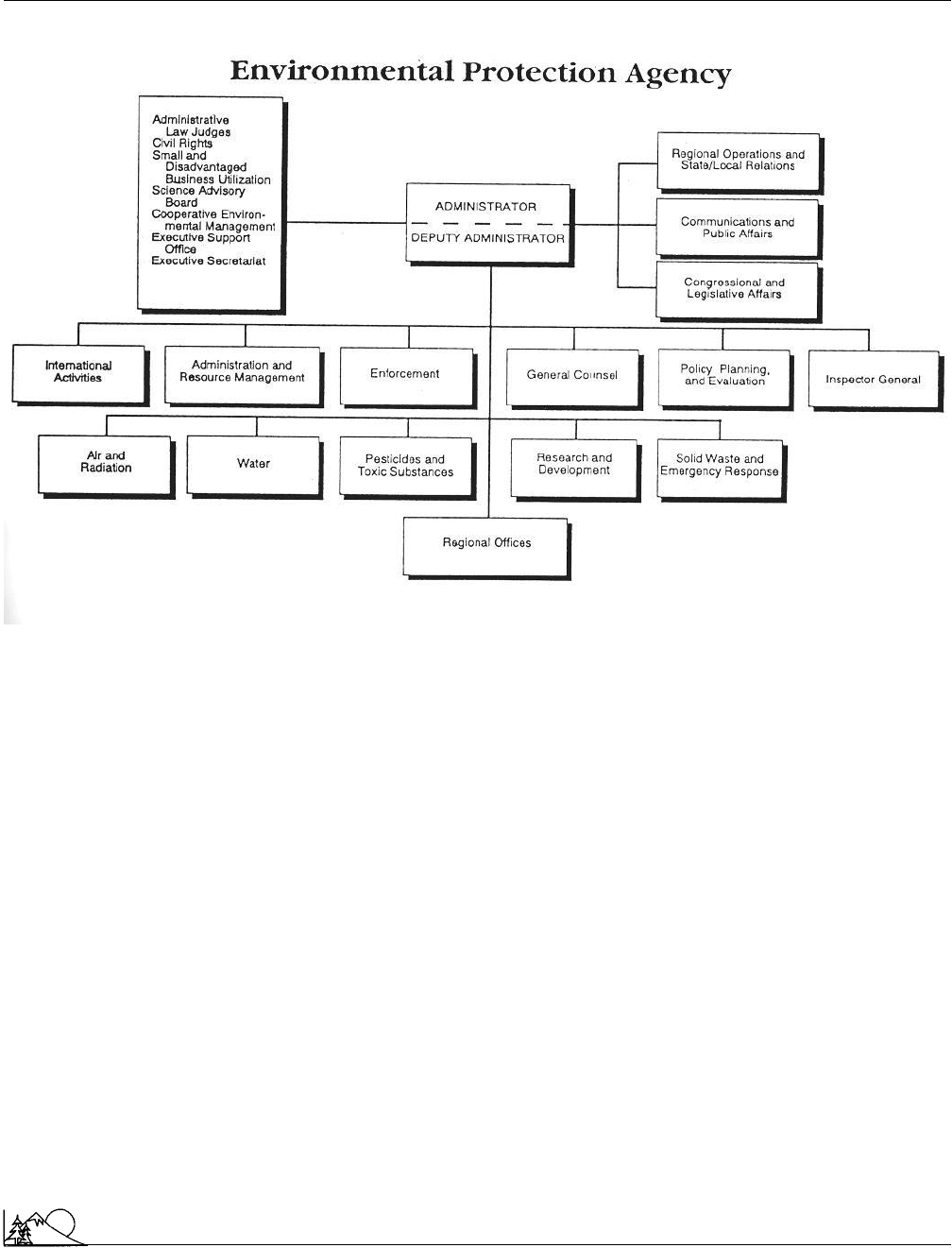Environmental Encyclopedia
Подождите немного. Документ загружается.


Environmental Encyclopedia 3
Environmental Protection Agency (EPA)
EPA into the cabinet-level position of Department of the
Environment, giving the agency more stature and power.
The EPA, the USFS and other federal environmental agen-
cies have announced a new “ecosystem” approach to resource
management and
pollution control
. In a bold first move,
Congressional Democratic leaders are simultaneously re-
viewing four major environmental statutes (the
Resource
Conservation and Recovery Act
[RCRA],
Clean Water
Act
[CWA],
Endangered Species Act
[ESA] and Su-
perfund) in the hopes of integrating the policies into a com-
prehensive program. See also Pollution Prevention Act
[Cathryn McCue and Kevin Wolf and Jeffrey Muhr]
R
ESOURCES
B
OOKS
Lave, Lester B. The Strategy of Social Regulation. Washington, DC: Brook-
ings Institution, 1981.
Logan, Robert, Wendy Gibbons, and Stacy Kingsbury. Environmental Issues
for the ’90s: A Handbook for Journalists. Washington DC: The Media Insti-
tute, 1992.
Portney, Paul R., ed. Public Policies for Environmental Protection. Washing-
ton, DC: Resources for the Future, 1991.
Wolf Jr., Charles. Markets or Government. Cambridge, Massachusetts:
MIT Press, 1988.
World Resources Institute. 1992 Environmental Almanac. Boston:
Houghton Mifflin Co., 1992.
P
ERIODICALS
Schneider, Keith. “What Price Clean Up?” New York Times, March 21–
26, 1993.
Smith, Fred. “A Fresh Look at Environmental Policy.” SEJ Journal 3
(Winter 1993).
O
THER
Browner, Carol. Administrator of U.S. Environmental Protection Agency,
comments during a press conference in Ann Arbor, MI. March 23, 1993.
Environmental and Energy Study Institute. Special Report. October 14,
1992.
Environmental Protection Agency
(EPA)
The Environmental Protection Agency (EPA) was estab-
lished in July of 1970, a landmark year for environmental
concerns, having been preceded by the passing of the
Na-
tional Environmental Policy Act
in January and the first
Earth Day
celebrations in April. President Richard Nixon
and Congress, working together in response to the growing
public demand for cleaner air, land, and water, sought to
create a new agency of the federal government structured to
make a coordinated attack on the pollutants that endanger
human health and degrade the
environment
. The EPA
was charged with repairing the damage already done to the
507
environment and with instituting new policies designed to
maintain a clean environment.
The EPA’s mission is “to protect human health and
to safeguard the natural environment.” At the time the EPA
was formed, at least fifteen programs in five different agen-
cies and cabinet-level departments were handling
environ-
mental policy
issues. For the EPA to work effectively, it
was necessary to consolidate the environmental activities
of the federal government into one agency.
Air pollution
control
, solid
waste management
, radiation control, and
the drinking water program were transferred from the U.S.
Department of Health, Education and Welfare (currently
known as the
U.S. Department of Health and Human
Services
). The
water pollution
control and pesticides re-
search programs were acquired from the
U.S. Department
of the Interior
. Registration and regulation of pesticides
was transferred from the
U.S. Department of Agriculture
,
and the responsibility for setting tolerance levels for pesti-
cides in food was acquired from the
Food and Drug Admin-
istration
. The EPA also took over from the
Atomic Energy
Commission
the responsibility for setting some environ-
mental radiation protection standards and assumed some
of the duties of the Federal Radiation Council. For some
environmental programs, the EPA works with other agen-
cies: for example, the United States Coast Guard and the
EPA work together on flood control, shoreline protection,
and
dredging
and filling activities. And, since most state
governments in the United States have their own environ-
mental protection departments, the EPA delegates the im-
plementation and enforcement of many federal programs to
the states.
The EPA’s headquarters is in Washington DC, and
there are ten EPA regional offices and field laboratories.
The main office develops national environmental policy and
programs, oversees the regional offices and laboratories, re-
quests an annual budget from Congress, and conducts re-
search. The regional offices implement national policies,
oversee the environmental programs that have been dele-
gated to the states, and review Environmental Impact State-
ments for federal actions. The field laboratories conduct
research, the data from which are used to develop policies
and provide analytical support for monitoring and enforce-
ment of EPA regulations, and for the administration of
permit programs.
The administrator of the EPA is appointed by the
President, subject to approval by the Senate. The same proce-
dure is used to appoint a deputy administrator, who assists
the administrator, and nine assistant administrators, who
oversee programs and support functions. Other posts include
the chief financial officer, who manages the EPA’ budget
and funding operations, the inspector general, who is respon-

Environmental Encyclopedia 3
Environmental Protection Agency (EPA)
sible for investigating environmental crimes, and a general
counsel, who provides legal support.
In addition to the administrative offices, the EPA is
organized into the following program offices: The Office of
Air and Radiation, the
American Indian Environmental
Office
, the Office of Enforcement and Compliance Assur-
ance, the Office of Environmental Justice, the Office of
Environmental Information, the History Office, the Office
of International Affairs, the Office of Prevention, Pesticides
and Toxic Substances, the Office of Research and Develop-
ment, the Science Policy Council, the office of
Solid Waste
and Emergency Response, and the Office of Water.
The current EPA Administrator, elected by President
George W. Bush, is Christie Whitman, formerly Governor
of New Jersey, who was sworn in on January 31, 2001.
Whitman’s official administrative philosophy is that envi-
ronmental goals are compatible with and are connected to
economic goals, and that relationships between citizens, pol-
icy makers, and private sector must be strengthened. The
nomination of Linda J. Fisher to the post of EPA Deputy
Administrator was confirmed by the U.S. Senate on May
24, 2001. Fisher, who formerly practiced law in Washington
DC and has served as Vice President and Corporate Officer
at the Monsanto Co. in St. Louis MO, is Whitman’ top
managerial and policy assistant.
One of the major activities of the EPA is the manage-
ment of Superfund sites. For many years, uncontrolled
dumping of hazardous chemical and industrial wastes in
abandoned warehouses and landfills continued without con-
cern for the potential impact on public health and the envi-
ronment. Concern over the extent of the hazardous-waste-
site problem led Congress to establish the Superfund Pro-
gram in 1980 to locate, investigate, and clean up the worst
such sites. The EPA’ Office of Emergency and Remedial
Response (OERR) oversees management of the program in
cooperation with individual states. When a hazardous-waste
site is discovered, the EPA is notified. The EPA makes a
preliminary assessment of the site and gives a numerical
score according to
Hazard Ranking System
(HRS), which
determines whether the site is placed on the
National Priori-
ties List
(NPL). As of May 29, 2002, 1221 sites were listed
on the final NPL, with 74 new sites proposed, 812 sites
were reported to have completed construction, and 258 sites
had been deleted from the list. The final NPL lists Superfund
sites in which the clean-up plan is under construction or
ongoing. NPL proposed sites include sites for which the
HRS indicates that placement on the final NPL is appro-
priate. Among currently proposed NPL sites are Air Force
Plant 85 near Columbus OH (
coal
deposits
leaching
sulfu-
ric
acid
, ammonia, and
heavy metals
), Blackbird Mine in
Lemhi ID (high levels of
arsenic
,
copper
, cobalt, and
nickel
in surface water and sediments of Meadow and Blackbird
508
Creeks downstream from mining tunnels and waste-rock
piles), the Omaha
Lead
site in Omaha, NE (lead
contami-
nated soil
near populated areas and
wetlands
) and the
Libby
Asbestos
site in Libby, MT (heavy asbestos exposures
and chromium, copper, and nickel deposits near wetlands
and fisheries). A final NPL site is deleted from the list when
it is determined that no further clean up is needed to protect
human health or the environment Finally, under Superfund’s
redevelopment program, former hazardous-waste sites have
been remade into office buildings, parking lots, or even
golf courses
to be re-integrated as productive parts of the
community.
The offices and programs of the EPA recognize a set
of main objectives, or “core functions.” These core functions
help define the agency’s mission and provide a common
focus for all agency activities. The core functions are:
O
Pollution
Prevention—taking measures to prevent pollu-
tion from being created rather than only cleaning up what
has already been released, also known as source reduction
O
Risk Assessment and Risk Reduction—identifying prob-
lems that pose the greatest risk to human health and the
environment and taking measures to reduce those risks
O
Science, Research and Technology—conducting research
that will help in developing environmental policies and
promoting innovative technologies to solve environmental
problems
O
Regulatory Development—developing requirements such
as operating procedures for facilities and standards for
emissions of pollutants
O
Enforcement—assuring compliance with established regu-
lations
O
Environmental Education—developing educational mate-
rials, serving as an information clearinghouse, and provid-
ing grant assistance to local educational institutions
Many EPA programs are established by legislation
enacted by Congress. For example, many of the activities
carried out by the Office of Solid Waste and Emergency
Response originated in the
Resource Conservation and
Recovery Act
(RCRA). Among other laws that form the
legal basis for the programs of the EPA are the National
Environmental Policy Act (NEPA) of 1969, which repre-
sents the basic national charter of the EPA, the
Clean Air
Act
(CAA) of 1970, the
Occupational Safety and Health
Act
(OSHA) of 1970, the
Endangered Species Act
(ESA)
of 1973, the
Safe Drinking Water Act
(SDWA) of 1974,
the Toxic Substances Control Act (TSCA) of 1976, the
Clean Water Act
(CWA) of 1977, the Superfund Amend-
ments and Reauthorization Act (SARA) of 1986, and the
Pollution Prevention Act
(PPA) of 1990. It is through such
legislation that the EPA obtains authority to develop and
enforce regulations. Environmental regulations drafted by

Environmental Encyclopedia 3
Environmental Protection Agency (EPA)
EPA organization chart. (Photograph by Tom Pantages. Reproduced by permission.)
the agency are subjected to intense review before being final-
ized. This process includes approval by the President’s
Office
of Management and Budget
and input from the private
sector and from other government agencies.
Public concern over the environmental changes with
time, and the EPA alters its policy priorities in response.
For example, in answer to growing concern regarding envi-
ronmental impact to children’s health, the Office of Chil-
dren’s Health Protection (OCHP) was created in May 1997.
On February 14, 2002, President George W. Bush an-
nounced the Clear Skies Initiative, which contain the farthest
reaching legislative changes to the Clean Air Act since 1990.
Growing public concern about water pollution led to
a landmark piece of legislation, the Federal Water
Pollution
Control
Act of 1972, amended in 1977 and commonly
known as the Clean Water Act. The Clean Water Act
gives the EPA the authority to administer pollution control
programs and to set
water quality standards
for contami-
nants of surface waters. October 18, 2002, marks the thirtieth
Anniversary of the enactment of the Clean Water Act. In
continuing support of the goals of this Act, Congress has
proclaimed 2002 as the “Year of Clean Water.”
509
As part of its mission as an information clearing house,
the EPA maintains an excellent web site at <http://www.ep-
a.gov> with countless links to supporting information of all
kinds. The web site also includes Spanish translations of
many documents, and links to children’s activities.
[Teresa C. Donkin]
R
ESOURCES
B
OOKS
Environmental Management. Washington, DC: U.S. Environmental Pro-
tection Agency, October 1991.
Keating, B., and D. Russell. “Inside the EPA: Yesterday and Today...Still
Hazy After All These Years.” E Magazine 3 (August 1992): 30–37.
O
THER
U.S. Environmental Protection Agency Laws and Regulations. Clean Water
Act. March 26, 2002 [cited July 10, 2002]. <http://www.epa.gov/region5/
water/cwa.htm>.
U.S. Environmental Protection Web Site. [cited July 10, 2002]. <http://
www.epa.gov>.

Environmental Encyclopedia 3
Environmental racism
Environmental racism
The term environmental racism was coined in a 1987 study
conducted by the United Church of Christ that examined
the location of
hazardous waste
dumps and found an
“insidious form of racism.” Concern had surfaced five years
before, when opposition to a polychlorinated biphenyl
(PCB)
landfill
prompted Congress to examine the location
of hazardous waste sites in the Southeast, the
Environmen-
tal Protection Agency
(EPA)’s Region IV. They found that
three of the four facilities in the area were in communities
primarily inhabited by people of color. Subsequent studies,
such as Ben Goldman’s The Truth about Where You Live,
have contended that exposure to environmental risks is sig-
nificantly greater for racial and ethnic minorities than for
nonminority populations. However, an EPA study contends
that there is not enough data to draw such broad conclusions.
The National Law Journal found that official response
to environmental problems may be racially biased. According
to their study, penalties for environmental crimes were
higher in white communities. They also found that the EPA
takes 20% longer to place a hazardous waste site in a minority
community on the Superfund’s
National Priorities List
(NPL). And, once assigned to the NPL, these clean ups are
more likely to be delayed.
Advocates also contend that environmentalists and
regulators have tried to solve environmental problems with-
out regard for the social impact of the solutions. For example,
the Los Angeles Air Quality Management District wanted
to require businesses to set up programs that would discour-
age their employees from driving to work. As initially con-
ceived, employers could have simply charged fees for parking
spaces without helping workers set up car pools. The Labor-
Community Strategy Center, a local activist group, pointed
out that this would have disproportionately affected people
who could not afford to pay for parking spaces. As a compro-
mise, regulators will now review employers’ plans and only
approve those that mitigate the any unequal effects on poor
and minority populations.
In response to the concern that traditional
environ-
mentalism
does not recognize the social and economic com-
ponents of environmental problems and solutions, a national
movement for “environmental and economic justice” has
spread across the country. Groups like the Southwest Net-
work for Environmental and Economic Justice attempt to
frame the
environment
as part of the fight against racism
and other inequalities.
In addition, the federal government has begun to ad-
dress the debate over environmental racism. In 1992, the
EPA established an Environmental Equity office. In addi-
tion, several bills that advocate environmental justice have
been introduced. See also Comprehensive Environmental
510
Response, Compensation, and Liability Act (CERCLA);
Environmental economics; Environmental law; Hazardous
waste siting; South
[Alair MacLean]
R
ESOURCES
B
OOKS
Alston, D., ed. We Speak for Ourselves: Social Justice, Race and Environment.
Washington, DC: The Panos Institute, 1990.
Goldman, B. A. The Truth About Where You Live: An Atlas for Action on
Toxins and Mortality. New York: Times Books, 1991.
Lee, C. Toxic Wastes ad Race in the United States: A National Report on the
Racial and Socio-Economic Characteristics of Communities with Hazardous
Waste Sites. New York: United Church of Christ, Commission for Racial
Justice, 1987.
U.S. Environmental Protection Agency. Environmental Equity: Reducing
Risk for All Communities: Report to the Administrator from the EPA Environ-
mental Equity Workgroup. Washington, DC: U.S. Government Printing
Office, 1992.
U.S. General Accounting Office. Siting of Hazardous Waste Landfills and
Their Correlation with Racial and Economic Status of Surrounding Communi-
ties. Washington, DC: U.S. Government Printing Office, 1983.
P
ERIODICALS
Russell, D. “Environmental Racism.” Amicus Journal 11 (Spring 1989):
22–32.
Environmental refugees
The term environmental refugee was coined in the late 1980s
by the
United Nations Environment Programme
and re-
fers to people who are forced to leave their community
of origin because the land can no longer support them.
Environmental factors such as
soil erosion
,
drought
,or
floods, which are often coupled with poor socioeconomic
conditions, are the cause of this loss of
stability
and security.
Many environmental influences may cause such a displace-
ment and include the deterioration of agricultural land, natu-
ral or “unnatural” disasters,
climate
change, the destruction
resulting from war, and environmental
scarcity
.
Environmental scarcity can be supply induced, demand
induced, or structural. Supply induced scarcity refers to the
depletion of agricultural resources, as in the erosion of crop-
land or
overgrazing
. Demand induced scarcity occurs when
consumption of a resource increases or when
population
growth
occurs, as is occurring in countries such as Philip-
pines, Kenya, and Costa Rica. Structural scarcity results
from the unequal social distribution of a resource within a
community. The causes of environmental scarcity can occur
simultaneously and in combination with each other, as seen
in South Africa during the years of apartheid. Approximately
60% of the cropland in South Africa is marked by low organic
content, and half of the country receives less than 19.5 in
(500 mm) of annual precipitation. When these factors were

Environmental Encyclopedia 3
Environmental refugees
coupled with the rapid soil erosion, overcrowding, and un-
equal social distribution of resources experienced at this time,
environmental scarcity resulted. Other environmental influ-
ences such as climate change and natural disasters can greatly
compound the problems related to scarcity. Those countries
which are especially vulnerable to these other influences
are those which are already experiencing the precursors to
scarcity, for example, highly populated countries such as
Egypt and Bangladesh. On Haiti, per capita grain produc-
tion is half of what it was only 40 years ago and residents
only get about 80% of their minimum nutritional needs.
Environmental problems place an added burden on a situa-
tion that is already under pressure. When this combination
occurs in societies without strong social ties or political and
economic stability, many times the people within the popula-
tion have no choice but to relocate.
Environmental refugees tend to come from rural areas
and developing countries--those most vulnerable to the in-
fluences of scarcity, climate change, and natural disasters.
According to the
Centers for Disease Control and Preven-
tion
, since the early 1960s most emergencies involving refu-
gees have taken place in these
less developed countries
where resources are inadequate to support the population
during times of need. In 1995, CDC directed 45 relief
missions to developing countries such as Angola, Bosnia,
Haiti, and Sierra Leone.
The number of displaced people is rising worldwide.
Of these, the number forced to migrate because of economic
and environmental conditions is growing more rapidly than
refugees from political strife. According to Dr. Norman
Myers at the University of Oxford, there are 25 million
environmental refugees today, compared with 20 million
officially recognized refugees migrating due to political, reli-
gious, or ethical problems. It has been predicted that by the
year 2010, this number could rise to 50 million. The number
of migrants seeking environmental refuge is grossly underes-
timated because many do not actually cross borders but
are forced to wander within their own country. As global
warming causes major climate changes, these numbers could
increase even more. Climate change alone may displace 150
million more people by the middle of the next century. Not
only would a global climate change increase the number of
refugees, it could have a negative impact on agricultural
production which would seriously limit the amount of food
surpluses available to help displaced people.
Although approximately three out of every five refu-
gees are fleeing from environmental hardships, this group
of refugees is not legally recognized. According to the 1951
Convention on the Status of Refugees as modified by the
1967 Protocol, a legal refugee is a person who escapes a
country and cannot re-enter due to fear of persecution for
reasons of race, religion, nationality, social affiliation, or
511
political opinion. This definition requires both the element
of persecution as well as cross-border
migration
. Because
of these two requirements, states are not legally compelled
to recognize environmental refugees; as mentioned above,
many of these refugees never leave their own country, and
it is unreasonable to expect them to prove fear of persecution.
Environmental refugees are often forced to enter a country
illegally since they cannot be granted protection or asylum.
Many of the Mexican immigrants who enter the United
States are escaping the sterile, unproductive land they have
been living on. Over 60% of the land in Mexico is degraded,
with soil erosion contributing to over 494,000 acres (200,000
ha) more land being rendered unproductive every year. Many
of the people considered to be economic migrants are actually
environmental refugees. Those that are recognized as politi-
cal refugees often must live in overcrowded refugee camps
which are no more prepared to sustain the population than
the land they are escaping from. Two thousand Somali refu-
gees forced to live in such camps on the border of Kenya
were displaced once more when
flooding
in 1994 ended a
long drought but destroyed relief food. Many environmental
refugees never resettle and must live the rest of their lives
migrating from place to place, looking for land that can
sustain them.
Researchers are currently working on ways to predict
where the next large migrations will come from and how to
prevent them from occurring. Predictive models are ex-
tremely difficult to produce because of the interaction be-
tween the socioeconomic status of the people and the envi-
ronmental influences on the land. Stuart Liederman, an
environmental scientist at the University of New Hampshire,
is developing a model which will predict which areas are at
risk of producing environmental refugees. This model is a
mathematical formula which could be used with any popula-
tion. One side of the equation combines the rate of environ-
mental decay, the amount of time over which this deteriora-
tion will take place, and the susceptibility of the people and
the
environment
. The other side of the equation combines
the restoration rate, the time it would take to reestablish the
environment, and the potential for recovery of the people
and the land. These predictions will allow for preventive
measures to be taken, for preparations to be made for future
refugees, and for restoring the devastated homelands of past
migrants. Creation of a working model may also help con-
vince policymakers that those escaping unlivable environ-
mental conditions need to be legally recognized as refugees.
Until environmental refugees are granted legal status,
there will be no protection or compensation granted these
individuals. The most effective way to deal with the growing
number of displaced persons is to concentrate on the reasons
they are being forced to leave their homelands. The increas-
ing number of people forced to leave their homeland due

Environmental Encyclopedia 3
Environmental resources
to ecological strife is an indicator of environmental quality.
Environmental protection is necessary to prevent the situa-
tion in many countries from getting worse. In the meantime,
measures must be taken to accommodate the needs of these
refugees, and the environment must be recognized as a legiti-
mate source of conflict for individuals seeking protection in
other lands.
[Jennifer L. McGrath]
R
ESOURCES
B
OOKS
Jacobson, J. L. Environmental Refugees: A Yardstick of Habitability.
Worldwatch Institute, 1988.
Tickell, C. “Environmental Refugees: The Human Impact of Global Envi-
ronmental Change.” In Greenhouse Glasnost: The Crisis of Global Warming,
edited by T. Minger. New York: Ecco Press, 1990.
Lindahl-Kiessling, K., and H. Landberg, eds. Population, Economic Develop-
ment, and the Environment. New York: Oxford University Press, 1994.
P
ERIODICALS
Fell, N. “Outcasts from Eden.” New Scientist Magazine 151, no. 2045
(August 1996): 24–7.
Homer-Dixon, T. F. “Environmental Change and Economic Decline in
Developing Countries.” International Studies Notes 16, no. 1 (Winter
1991): 18.
Myers, N. “Environmental Refugees in a Globally Warmed World.” BioSci-
ence 43, no. 11 (December 1993): 752–61.
O
THER
Centers for Disease Control. Famine Affected, Refugee, and Displaced Popula-
tions: Recommendations For Public Health Issues. MMWR 1992; 41 (No
RR-13).
Environmental resources
An environmental resource is any material, service, or infor-
mation from the
environment
that is valuable to society.
This can refer to anything that people find useful in their
environs, or surroundings. Food from plants and animals,
wood for cooking, heating, and building, metals,
coal
, and
oil are all environmental resources. Clean land, air, and water
are environmental resources, as are the abilities of land, air,
and water to absorb society’s waste products. Heat from the
sun,
transportation
and
recreation
in lakes, rivers, and
oceans, a beautiful view, or the discovery of a new
species
are all environmental resources.
The environment provides a vast array of materials
and services that people use to live. Often these resources
have competing uses and values. A piece of land, for instance,
could be used as a farm, a park, a parking lot, or a housing
development. It could be mined or used as a
garbage
dump.
The topic of environmental resources, then, raises the ques-
tion, what do people find valuable in their environment,
512
and how do people choose to use the resources that their
environment provides?
Some resources are renewable, or infinite, and some
are non-renewable, or finite. Renewable resources like energy
from the sun are plentiful and will be available for a long
time. Finite resources, like oil and coal, are non-renewable
because once they are extracted from the earth and burned
they cannot be used again. These resources are in limited
supply and need to be used carefully. Many resources are
becoming more and more limited, especially as population
and industrial growth place increasing pressure on the envi-
ronment. Before the Industrial Revolution, for example, peo-
ple relied on their own strength and their animals for work
and transportation. The invention of the steam engine in
the 1850s radically altered peoples’ ability to do work and
to consume energy. Today we have transformed our environ-
ment with machines, cars, and
power plants
and in the
process we have burnt extraordinary amounts of coal, oil,
and
natural gas
. Some predict that world coal deposits will
last another 200 years, while oil and natural gas reserves will
last another one hundred years at current rates of consump-
tion. This rate of use is clearly not sustainable. The terms
finite and infinite are important because they indicate how
much of a given resource is available, and how fast people
can use that resource without limiting future supplies.
Some resources that were once taken for granted are
now becoming more valuable. One of these resources is
the environment’s ability to absorb the waste that people
produce. In Jakarta, Indonesia, people living in very close
quarters in small shanties along numerous tidal canals use
their only water supply for bathing, washing clothes, drink-
ing water, fishing, and as a toilet. It is common to see
people bathing just down stream from other people who are
defecating directly into the river. This scene illustrates a
central problem in environmental resource management.
These people have only one water source and many needs
in order to live. The demands that they place on these
resources seriously affect the health and quality of life for
all the people, but all of the needs must be met in some
way. Thoughtful management of these environmental re-
sources, like building latrines, could alleviate some of the
strain on the river and improve other uses of the same
resource. People all over the world have taken for granted
the valuable resources of air, land, and
water quality
so
that many rivers are undrinkable and unswimable because
they contain raw sewage, chemical fertilizers, and industrial
wastes. As people make decisions about what they will take
from their environment, they also must be conscious of what
they intend to put back into that environment.
Resource economics was established during a time in
human history when environmental resources were thought
to be limitless and without value until they were harvested

Environmental Encyclopedia 3
Environmental science
and brought to market. From this viewpoint, the world is
big enough that when one resource is exhausted another
resource can be found to take its place. Land is valuable
according to what can be taken from it in order to make a
profit. This kind of management leads to enormous short
term gains and is responsible for the speed and efficiency
of economic growth throughout the world. One the other
hand, this view overlooks longer term profits and the reality
that the world is an increasingly small, interconnected, and
fragile system. People can no longer assume that they can
find fresh new supplies when they use up what they have.
Very few places on earth remain untouched and unexploited.
The world’s remaining forests, if managed with care,
could supply all of society’s needs for timber and still remain
relatively healthy and intact. Forest resources can be renew-
able, since forests grow quickly enough to replace themselves
if used in moderation. Unfortunately, in many places forests
are being destroyed at an alarming rate. In Costa Rica,
Central America, 25% of the remaining forest land has disap-
peared since 1970. These forests have been cleared to harvest
tropical hardwoods, to create farmland and pasture for ani-
mals, and to forage wood for cooking and heating. In a
country struggling for economic growth, these are all impor-
tant needs, but they do not always make long term economic
sense. Farmers who graze cattle in tropical rain forests or
who clear trees off of steep hillsides destroy their land in a
matter of years with the idea that this is the fastest way to
make money. In the same way, loggers harvest trees for
immediate sale, even though many of these trees take hun-
dreds of years to replenish themselves. In fact, the price for
tropical hardwoods has gone up four-fold since 1970. The
trees cut and sold in 1970 represent a huge economic loss
to the Costa Rican economy, since they were sold for a
fraction of their present value. Often, the
soil
on this land
quickly erodes downhill into streams and rivers, clogging
the rivers with
sediment
and killing fish and other
wildlife
.
This has the added drawback of damaging hydroelectric and
irrigation dams
and hurting the fishing industry.
Despite these tragic losses, Costa Rica is a model in
Central America and in the world for finding alternative uses
for its
natural resources
. Costa Rica has set aside one fifth
of its total land area for
nature
preserves and
national park
lands. These beautiful and varied parks are valuable for several
reasons. First, they help to protect and preserve a huge diver-
sity of tropical species, many undiscovered and unstudied.
Second, they protect a great deal of vegetation that is impor-
tant in producing oxygen, stabilizing atmospheric chemistry,
and preventing global
climate
change. Third, the natural
beauty of these parks attracts many international tourists.
Tourism is one of Costa Rica’s major industries, providing
much needed economic development. People from around
the world appreciate the beauty and the wonder—the intangi-
513
ble values—of these resources. Local people who would have
been hired one time to cut down a forest can now be hired for
a lifetime to work as park rangers and guides. Some would
also argue that these nature preserves have value in themselves
without reference to human needs, simply because they are
filled with beautiful living birds, insects, plants, and animals.
Much of the dialogue in environmental resource man-
agement is about the need to balance the needs for economic
growth and prosperity with needs for sustainable resource
use. In a limited, finite world, there is a need to close the
gap between the rates of consumption and rates of supply.
The debate over how to assign value to different environmen-
tal resources is a lively one because the way that people think
about their environment directly affects how they interact
with the world.
[John Cunningham]
R
ESOURCES
B
OOKS
Ahmad, Y., et al. Environmental Accounting and Sustainable Development:
A UNEP World Bank Symposium. Washington, DC: World Bank, 1989.
P
ERIODICALS
Repetto, R. “Accounting for Environmental Assets.” Scientific American
266 (June 1992): 94–8+.
Environmental restoration
see
Restoration ecology
Environmental risk analysis
see
Risk analysis
Environmental science
Environmental science is often confused with other fields of
related interest, especially
ecology
, environmental studies,
environmental education
, and
environmental engi-
neering
. Renewed interest in environmental issues in the
late 1960s and early 1970s, gave rise to numerous programs
at many universities in the United States and other countries,
most under two rubrics: environmental science or environ-
mental studies. The former focused, as might be expected,
on scientific questions and issues of environmental interest;
the latter were often courses, with the emphasis on questions
of
environmental ethics
, aesthetics, literature, etc.
These new academic units marked the first formal
appearance of environmental science on most campuses, at
least by that label. But environmental science is essentially
the application of scientific methods and principles to the

Environmental Encyclopedia 3
Environmental stress
study of environmental questions, so it has probably been
around in some form as long as science itself. Air and
water
quality
research, for example, have been carried on in many
universities for many decades: that research is environmental
science.
By whatever label and in whatever unit, environmental
science is not constrained within any one discipline; it is a
comprehensive field. A considerable amount of environmen-
tal research is accomplished in specific departments such as
chemistry, physics, civil engineering, or the various biology
disciplines. Much of this work is confined to a single field,
with no interdisciplinary perspective. These programs gradu-
ate scientists who build on their specific training to continue
work on environmental problems, sometimes in a specific
department, sometimes in an interdisciplinary environmen-
tal science program.
Many new academic units are interdisciplinary, their
members and graduates specifically designated as environ-
mental scientists. Most have been trained in a specific disci-
pline, but they may have degrees from almost any scientific
background. In these units, the degrees granted—from B.S.
to Ph.D.—are in Environmental Science, not in a specific
discipline.
Environmental science is not ecology, though that
discipline may be included. Ecologists are interested in the
interactions between some kind of organism and its sur-
roundings. Most ecological research and training does not
focus on environmental problems except as those problems
impact the organism of interest. Environmental scientists
may or may not include organisms in their field of view:
they mostly focus on the environmental problem, which may
be purely physical in
nature
. For example,
acid deposition
can be studied as a problem of emissions and characteristics
of the
atmosphere
without necessarily examining its impact
on organisms. An alternate focus might be on the
acidifica-
tion
of lakes and the resulting implications for resident fish.
Both studies require expertise from more than one traditional
discipline; they are studies in environmental science. See also
Air quality; Environment; Environmental ethics; Nature;
Water quality
[Gerald L. Young Ph.D.]
R
ESOURCES
B
OOKS
Cunningham, W. P. Environmental Science: A Global Concern. Dubuque,
IA: William C. Brown, 1992.
Henry, J. G., and G. W. Heinke. Environmental Science and Engineering.
Englewood Cliffs, NJ: Prentice-Hall, 1989.
Jorgensen, S. E., and I. Johnson. Principles of Environmental Science and
Technology. 2nd ed. Amsterdam, NY: Elsevier, 1989.
514
Environmental stress
In the ecological context, environmental stress can be consid-
ered any environmental influence that causes a discernible
ecological change, especially in terms of a constraint on
ecosystem
development. Stressing agents (or stressors) can
be exogenous to the ecosystem, as in the cases of long-range
transported acidifying substances, toxic gases, or pesticides.
Stress can also cause change as a result of an accentuation
of some pre-existing site factor beyond a threshold for bio-
logical tolerance, for example thermal
loading
,
nutrient
availability, wind, or temperature extremes.
Often implicit within the notion of environmental
stress, particularly from the perspective of ecosystem manag-
ers, is a judgement about the quality of the ecological change.
That is, from the human perspective, whether the effect is
“good” or “bad.”
Environmental stressors can be divided into several,
not necessarily exclusive, classes of causal agencies:
O
“Physical stress” refers to episodic events (or disturbance)
associated with intense but usually brief loadings of kinetic
energy, perhaps caused by a windstorm, volcanic eruption,
tidal wave, or an explosion.
O
Wildfire is another episodic stress, usually causing a mass
mortality
of ecosystem dominants such as trees or shrubs
and a rapid
combustion
of much of the
biomass
of the
ecosystem.
O
Pollution occurs when certain
chemicals
are bio-available
in a sufficiently large amount to cause toxicity. Toxic stres-
sors include gaseous air pollutants such as
sulfur dioxide
and
ozone
, metals such as
lead
and
mercury
, residues of
pesticides, and even nutrients that may be beneficial at
small rates of supply but damaging at higher rates of
loading.
O
Nutrient impoverishment implies an inadequate availability
of physiologically essential chemicals, which imposes an
oligotrophic
constraint upon ecosystem development.
O
Thermal stress occurs when heat energy is released into
an ecosystem, perhaps by aquatic discharges of low-grade
heat from
power plants
and other industrial sources.
O
Exploitative stress refers to the selective removal of particu-
lar
species
or size classes. Exploitation by humans includes
the harvesting of forests or wild animals, but it can also
involve natural herbivory and predation, as with infesta-
tions of defoliating insects such as locusts, spruce budworm,
or
gypsy moth
, or irruptions of predators such as crown-
of-thorns starfish.
O
Climatic stress is associated with an insufficient or excessive
regime of moisture, solar radiation, or temperature. These
can act over the shorter term as weather, or over the longer
term as
climate
.

Environmental Encyclopedia 3
Environmental Working Group
Within most of these contexts, stress can be exerted
either chronically or episodically. For example, the toxic
gas sulfur dioxide can be present in a chronically elevated
concentration in an urbanized region with a large number
of point sources of
emission
. Alternatively, where the emis-
sion of sulfur dioxide is dominated by a single, large
point
source
such as a
smelter
or power plant, the toxic stress
associated with this gas occurs as relatively short-term events
of
fumigation
.
Environmental stress can be caused by natural agencies
as well as resulting directly or indirectly from the activities
of humans. For example, sulfur dioxide can be emitted from
smelters, power plants, and homes, but it can also be emitted
in large quantities by volcanoes. Similarly, climate change
has always occurred naturally, but it may also be forced by
human activities that result in emissions of
carbon dioxide
,
methane
, and
nitrous oxide
into the
atmosphere
.
Over most of Earth’s history, natural stressors have
been the dominant constraints on ecological development.
Increasingly, however, the direct and indirect consequences
of human activities are becoming dominant environmental
stressors. This is caused by both the increasing human popu-
lation and by the progressively increasing intensification of
the per-capita effect of humans on the
environment
.
[Bill Freedman Ph.D.]
R
ESOURCES
B
OOKS
Freedman, B. “Environmental Stress and the Management of Ecological
Reserves.” In Science and the Management of Protected Areas, edited by J.
H. M. Willison, et al. Amsterdam: Elsevier, 1992.
Grime, J. P. Plant Strategies and Vegetation Processes. New York: Wiley, 1979.
Environmental Stress Index
Environmental Stress
Index (ZPG) is a survey to determine
the quality of life in American cities. Zero Population
Growth, Inc. based in Washington D.C., conducted this
“Urban Stress Test” in the late 1980s. One hundred and
ninety-two cities were selected throughout the United States.
The population-linked survey was based on 11 criteria: Pop-
ulation change; Population density; Education; Violent
crime; Community economics; Individual economics (per-
cent below federal poverty level and per capita income);
Births (percent of teenage births and infant
mortality
);
Air
quality
(meeting
Environmental Protection Agency
(EPA) standards);
Hazardous waste
(number of EPA-
designated hazardous waste sites); Water (quality and sup-
ply); Sewage (model cities provide better than secondary
treatment of their
wastewater
).
515
Cites were ranked one to six with number one being
best. The cities with the lower scores were called model
cities. The cities with the higher scores were called the
stressed cities. Among the model cities were Abilene, Texas,
with an index of 1.6; Roanoke, Virginia, 1.6; Berkeley, Cali-
fornia, 2.0; Colorado Springs, Colorado, 2.0; and Peoria,
Illinois, 2.0.
Among America’s worst cities were Phoenix, Arizona,
5; Houston, Texas, 4.5; Los Angeles, 4.3; Honolulu, Hawaii,
4.3; and Baltimore, Maryland, 4.3.
Environmental Working Group
The Environmental Working Group is a public interest
research group that monitors public agencies and public
policies on topics relating to environmental and social justice.
EWG publicizes its findings in research reports that empha-
size both national and local implications of federal laws and
activities. These research reports are based on analysis of
public databases, often obtained through the Freedom of
Information Act. In operation since 1993, EWG is a non-
profit organization funded by grants from private founda-
tions. EWG is based in Washington, D.C. and Oakland,
California, and is associated with the Tides Center of San
Francisco. The organization performs its research both inde-
pendently and in collaboration with other public interest
research groups such as the
Sierra Club
and the Surface
Transportation
Policy Project (a nonprofit coalition focus-
ing on social and environmental quality in transportation
policy).
EWG specializes in analyzing large computer data-
bases maintained by government agencies, such as the Toxic
Release Inventory database maintained by the
Environmen-
tal Protection Agency
to record spills of toxic
chemicals
into the air or water, or the Regulatory Analysis Manage-
ment System, maintained by the
Army Corps of Engineers
for internal tracking of permits granted for filling and drain-
ing
wetlands
. Because many of these data sources are capa-
ble of exposing actions or policies embarrassing to public
agencies, EWG has often obtained data by using the Free-
dom of Information Act, which legally enforces public re-
lease of data belonging to the public domain. Many of the
databases researched by EWG have never been thoroughly
analyzed before, even by the agency collecting the data.
EWG is unusual in working with primary data—going di-
rectly to the original database—rather than basing its re-
search on secondary sources, anecdotal information, or inter-
views.
Research findings are published both in print and elec-
tronically on the Internet. Electronic publishing allows im-
mediate and inexpensive distribution of reports that concern

Environmental Encyclopedia 3
Environmentalism
issues of current interest. EWG is a prolific source of infor-
mation, producing extensive, detailed reports, often at a rate
of more than one a month. Among the environmental topics
on which the EWG has reported are drinking
water qual-
ity
, wetland protection and destruction, and the impacts of
agricultural pesticides on both farm workers and consumers.
Social justice and policy issues that EWG has researched
include campaign finance reform, inequalities and ineffi-
ciency in farm subsidy programs, and threats to public health
and the
environment
from
medical waste
. For each gen-
eral topic, EWG usually publishes a series of articles ranging
from the nature and impacts of a federal law to what individ-
uals can do about the current problem. Also included with
research reports are state-by-state and county summaries of
statistics
, which provide details of local implications of the
general policy issues.
[Mary Ann Cunningham Ph.D.]
R
ESOURCES
B
OOKS
Cook, K. A., and A. Art. City Slickers: Farm Subsidy Recipients in America’s
Big Cities. Washington, DC: Environmental Working Group, 1995.
Environmental Working Group. Dishonorable Discharge: Toxic Pollution of
America’s Waters. Washington, DC: Environmental Working Group, 1996.
O
RGANIZATIONS
Environmental Working Group, 1718 Connecticut Ave., NW, Suite 600,
Washington, D.C. USA 20009 (202) 667-6982, Fax: (202) 232-2592,
Email: info@ewg.org, <http://www.ewg.org>
Environmentalism
Environmentalism is the ethical and political perspective
that places the health, harmony, and integrity of the natural
environment
at the center of human attention and concern.
From this perspective human beings are viewed as part of
nature
rather than as overseers. Therefore to care for the
environment is to care about human beings since we cannot
live without the survival of the natural
habitat
.
Although there are many different views within the
very broad and inclusive environmentalist perspective, several
common features can be discerned. The first is environmen-
talism’s emphasis on the interdependence of life and the
conditions that make life possible. Human beings, like other
animals, need clean air to breathe, clean water to drink, and
nutritious food to eat. Without these necessities, life would
be impossible. Environmentalism views these conditions as
being both basic and interconnected. For example, fish con-
taminated with polychlorinated biphenyl (PCB),
mercury
,
and other toxic substances are not only hazardous to humans
but to bears, eagles, gulls, and other predators. Likewise,
mighty
whales
depend on tiny
plankton
, cows on corn,
516
koala bears on eucalyptus leaves, bees on flowers, and flowers
on bees and birds, and so on through all
species
and ecosys-
tems. All animals, human and nonhuman alike, are interde-
pendent participants in the cycle of birth, life, death, decay,
and rebirth.
A second emphasis of environmentalism is on the
sanctity of life—not only human life but all life, from
the tiniest microorganism to the largest whale. Since the
fate of our species is inextricably tied with theirs and
since life requires certain conditions to sustain it, environ-
mentalists contend that we have an obligation to respect
and care for the conditions that nurture and sustain life
in its many forms.
While environmentalists agree on some issues, there
are also a number of disagreements about the purposes of
environmentalism and about how to best achieve those ends.
Some environmentalists emphasize the desirability of con-
serving
natural resources
for
recreation
, sightseeing,
hunting
, and other human activities, both for present and
future generations
. Such a utilitarian view has been sharply
criticized by Arne Naess and other proponents of
deep
ecology
who claim that the natural environment has its
own
intrinsic value
apart from any aesthetic, recreational,
or other value assigned to it by human beings. Bears, for
example, have their own intrinsic value or worth, quite apart
from that assigned to their existence via
shadow pricing
or other mechanism by bear-watchers, hunters, or other
human beings.
Environmentalists also differ on how best to conserve,
reserve, and protect the natural environment. Some groups,
such as the
Sierra Club
and
the Nature Conservancy
, favor
gradual, low-key legislative and educational efforts to inform
and influence policy makers and the general public about
environmental issues. Other more radical environmental
groups, such as the
Sea Shepherd Conservation Society
and
Earth First!
, favor carrying out direct action by em-
ploying the tactics of ecotage (ecological sabotage), or
mon-
key-wrenching
, to stop
strip mining
,
logging
, drift net
fishing, and other activities that they deem dangerous to
animals and ecosystems. Within this environmental spec-
trum are many other groups, including the
World Wildlife
Fund
,
Greenpeace
,
Earth Island Institute
, Clean Water
Action, and other organizations which use various tech-
niques to inform, educate, and influence public opinion re-
garding environmental issues and to lobby policy makers.
Despite these and other differences over means and
ends, environmentalists agree that the natural environment,
whether valued instrumentally or intrinsically, is valuable
and worth preserving for present and future generations.
[Terence Ball]
